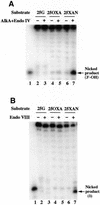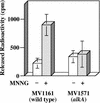Novel repair activities of AlkA (3-methyladenine DNA glycosylase II) and endonuclease VIII for xanthine and oxanine, guanine lesions induced by nitric oxide and nitrous acid
- PMID: 12434002
- PMCID: PMC137176
- DOI: 10.1093/nar/gkf630
Novel repair activities of AlkA (3-methyladenine DNA glycosylase II) and endonuclease VIII for xanthine and oxanine, guanine lesions induced by nitric oxide and nitrous acid
Abstract
Nitrosation of guanine in DNA by nitrogen oxides such as nitric oxide (NO) and nitrous acid leads to formation of xanthine (Xan) and oxanine (Oxa), potentially cytotoxic and mutagenic lesions. In the present study, we have examined the repair capacity of DNA N-glycosylases from Escherichia coli for Xan and Oxa. The nicking assay with the defined substrates containing Xan and Oxa revealed that AlkA [in combination with endonuclease (Endo) IV] and Endo VIII recognized Xan in the tested enzymes. The activity (V(max)/K(m)) of AlkA for Xan was 5-fold lower than that for 7-methylguanine, and that of Endo VIII was 50-fold lower than that for thymine glycol. The activity of AlkA and Endo VIII for Xan was further substantiated by the release of [(3)H]Xan from the substrate. The treatment of E.coli with N-methyl-N'-nitro-N-nitrosoguanidine increased the Xan-excising activity in the cell extract from alkA(+) but not alkA(-) strains. The alkA and nei (the Endo VIII gene) double mutant, but not the single mutants, exhibited increased sensitivity to nitrous acid relative to the wild type strain. AlkA and Endo VIII also exhibited excision activity for Oxa, but the activity was much lower than that for Xan.
Figures








Similar articles
-
Preparation and enzymatic recognition of guanine lesions induced by nitrogen oxides.Nucleic Acids Symp Ser. 2000;(44):87-8. doi: 10.1093/nass/44.1.87. Nucleic Acids Symp Ser. 2000. PMID: 12903281
-
Endonuclease V protects Escherichia coli against specific mutations caused by nitrous acid.Mutat Res. 1999 Dec 7;435(3):245-54. doi: 10.1016/s0921-8777(99)00049-x. Mutat Res. 1999. PMID: 10606815
-
Enzymatic repair of 5-formyluracil. I. Excision of 5-formyluracil site-specifically incorporated into oligonucleotide substrates by alka protein (Escherichia coli 3-methyladenine DNA glycosylase II).J Biol Chem. 1999 Aug 27;274(35):25136-43. doi: 10.1074/jbc.274.35.25136. J Biol Chem. 1999. PMID: 10455195
-
Neil3, the final frontier for the DNA glycosylases that recognize oxidative damage.Mutat Res. 2013 Mar-Apr;743-744:4-11. doi: 10.1016/j.mrfmmm.2012.12.003. Epub 2012 Dec 26. Mutat Res. 2013. PMID: 23274422 Free PMC article. Review.
-
Oxidative base damage to DNA: specificity of base excision repair enzymes.Mutat Res. 2000 Apr;462(2-3):121-8. doi: 10.1016/s1383-5742(00)00022-3. Mutat Res. 2000. PMID: 10767623 Review.
Cited by
-
Structural insights into the bypass of the major deaminated purines by translesion synthesis DNA polymerase.Biochem J. 2020 Dec;477(24):4797-4810. doi: 10.1042/BCJ20200800. Epub 2020 Dec 24. Biochem J. 2020. PMID: 33258913 Free PMC article.
-
Kinetic mechanism for the excision of hypoxanthine by Escherichia coli AlkA and evidence for binding to DNA ends.Biochemistry. 2011 May 24;50(20):4350-9. doi: 10.1021/bi200232c. Epub 2011 Apr 28. Biochemistry. 2011. PMID: 21491902 Free PMC article.
-
Defects in purine nucleotide metabolism lead to substantial incorporation of xanthine and hypoxanthine into DNA and RNA.Proc Natl Acad Sci U S A. 2012 Feb 14;109(7):2319-24. doi: 10.1073/pnas.1118455109. Epub 2012 Jan 30. Proc Natl Acad Sci U S A. 2012. PMID: 22308425 Free PMC article.
-
Identification of Escherichia coli mismatch-specific uracil DNA glycosylase as a robust xanthine DNA glycosylase.J Biol Chem. 2010 Dec 31;285(53):41483-90. doi: 10.1074/jbc.M110.150003. Epub 2010 Sep 17. J Biol Chem. 2010. PMID: 20852254 Free PMC article.
-
Excision of formamidopyrimidine lesions by endonucleases III and VIII is not a major DNA repair pathway in Escherichia coli.Nucleic Acids Res. 2005 Jun 8;33(10):3331-8. doi: 10.1093/nar/gki655. Print 2005. Nucleic Acids Res. 2005. PMID: 15944451 Free PMC article.
References
-
- Frederico L.A., Kunkel,T.A. and Shaw,B.R. (1990) A sensitive genetic assay for the detection of cytosine deamination: determination of rate constants and the activation energy. Biochemistry, 29, 2532–2537. - PubMed
-
- Lindahl T. (1993) Instability and decay of the primary structure of DNA. Nature, 362, 709–715. - PubMed
-
- Hill-Perkins M., Jones,M.D. and Karran,P. (1986) Site-specific mutagenesis in vivo by single methylated or deaminated purine bases. Mutat. Res., 162, 153–163. - PubMed
-
- Friedberg E.C., Walker,G.C. and Siede,W. (1995) DNA Repair and Mutagenesis. ASM Press, Washington, DC.
Publication types
MeSH terms
Substances
LinkOut - more resources
Full Text Sources
Molecular Biology Databases

